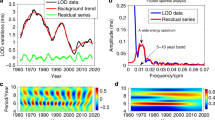Abstract
GEOMAGNETIC ACTIVITY is driven by the solar wind, so information on the past history of the wind can be derived from studies of geomagnetic indices1–3. Comparison of geomagnetic activity and sunspot number over the past hundred years shows that although both vary with the 11-yr solar cycle, they do so with characteristically different patterns. Geomagnetic activity rises and falls with about the same amplitude over each 11-yr solar cycle, but these variations seem to be superposed on a longer-term cycle of similar amplitude. Consequently there is a long-term variation in the 11-yr cycle minima as well as maxima. In contrast, in the sunspot number record the long cycle appears as changing amplitudes of the 11-yr cycles, with sunspot number returning to near zero at each 11-yr minimum. As geomagnetic activity reflects solar wind conditions, it is possible to extrapolate backwards in time the present-day solar wind measurements taken near the long-cycle maximum and we estimate here that around 1900, near the long-cycle minimum, either the average solar wind speed was as much as a factor of two lower, or the average southward component of the solar wind field was as much as a factor of three smaller, or both parameters were significantly less than at present. Thus, in the not too distant past the solar energy output by means of the solar wind was different from what it is now.
This is a preview of subscription content, access via your institution
Access options
Subscribe to this journal
Receive 51 print issues and online access
$199.00 per year
only $3.90 per issue
Buy this article
- Purchase on Springer Link
- Instant access to full article PDF
Prices may be subject to local taxes which are calculated during checkout
Similar content being viewed by others
References
Svalgaard, L. J. geophys. Res. 77, 4027–4034 (1972).
Russell, C. T. Solar Phys. 42, 259–269 (1975).
Gosling, J. T., Asbridge, J. R. & Bame, S. J. J. geophys. Res. 82, 3311–3314 (1977).
Fritz, H. Vierteljahrsschrift der Naturforsch. Gesselsch., 4, Zurich, 122 (1864).
Fraser-Smith, A. C. J. geophys. Res. 77, 4209–4220 (1972).
Newton, H. W. Mon. Not. R. astr. Soc., Geophys. Suppl. 5, 159–185 (1948).
Brown, G. M. Mon. Not. R. astr. Soc. 174, 185–189 (1976).
Mayaud, P. N. J. geophys. Res. 80, 111–122 (1975).
Hirshberg, J. Astrophys. Space Sci. 20, 473–481 (1973).
Crooker, N. U., Feynman, J. & Gosling, J. T. J. geophys. Res. 82, 1933–1937 (1977).
Siscoe, G. L., Crooker, N. U. & Christopher, L. Solar Physics 56, 449–461 (1978).
Parker, E. N. Astrophys. J. 128, 664–675 (1958).
Author information
Authors and Affiliations
Rights and permissions
About this article
Cite this article
FEYNMAN, J., CROOKER, N. The solar wind at the turn of the century. Nature 275, 626–627 (1978). https://doi.org/10.1038/275626a0
Received:
Accepted:
Issue Date:
DOI: https://doi.org/10.1038/275626a0
Comments
By submitting a comment you agree to abide by our Terms and Community Guidelines. If you find something abusive or that does not comply with our terms or guidelines please flag it as inappropriate.



